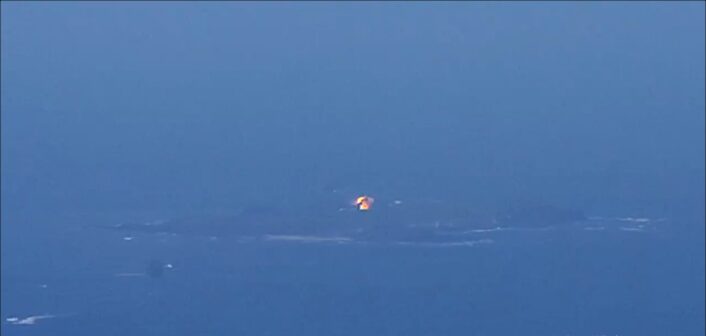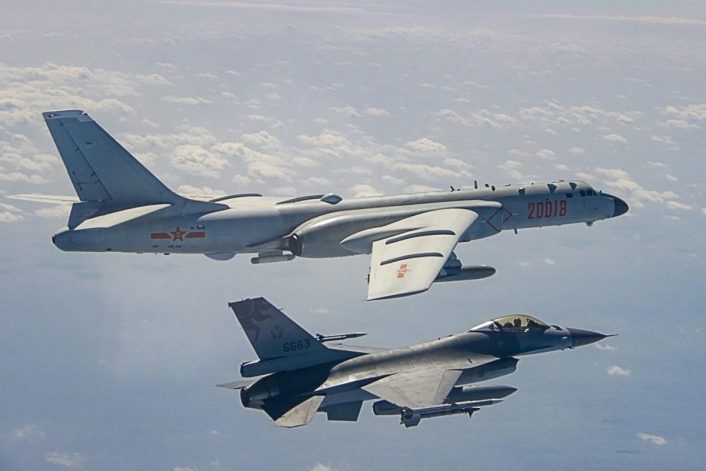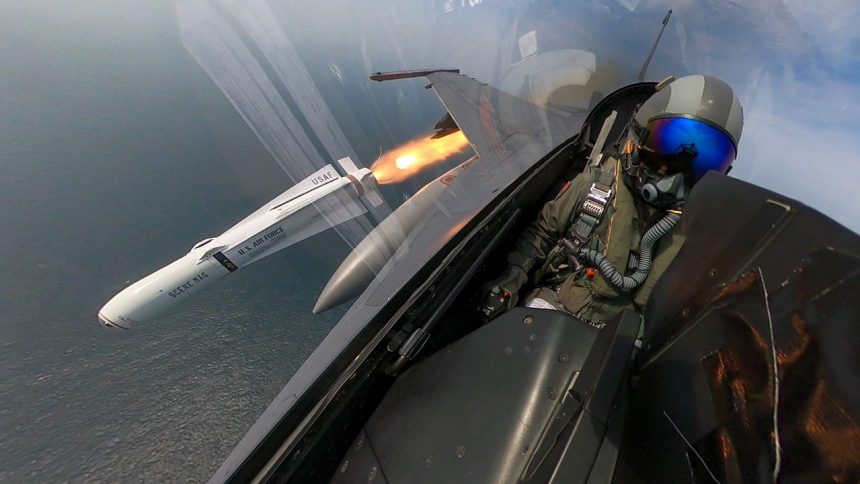The missile is used for close-range precision strikes on tactical targets like combat vehicles, fortified bunkers and artillery positions.
Amid rising military threats from China, which see People’s Liberation Army (PLA) Navy and Air Force aircraft and ships regularly making provocative maneuvers around the island, a drill by Taiwan’s air force saw its F-16 fighters fire an air-to-ground missile. Taiwan’s military released a video of an AGM-65 Maverick leaving the right wing of an F-16 and striking a target on a small island.
The video showed a two-seat F-16V taking off from the air base in Chiyai, with two Maverick missiles – one each on the middle pylon of each wing. The video from inside the cockpit showed the Maverick on the right wing swiftly leaving the rail. Another footage captures the missile striking the top of a small island.
The Exercise
The firing was a part of the Republic of China Air Force’s (RoCAF) “annual air-to-surface live ammunition delivery training.” According to Liberty Times, the shooting of an AGM-65 is “rarely revealed.” Part of the exercises also involved the RoCAF dropping “GBU-12 laser-guided bombs and Mk82 winged-assisted glide bombs into offshore target areas.”
罕見畫面☝️!F-16V 戰機裝掛「AGM-65B小牛飛彈」對陸上目標實施炸射!#ROCArmedForce #ROCAF #F16V #ProtectOurCountry #ROC #Taiwan🇹🇼 pic.twitter.com/jblZarCY4r— 軍聞社 Military News Agency, ROC(Taiwan)🇹🇼 (@mna_roc) May 9, 2024
The sea reef that the missile hit was a part of Taiwan’s Penghu Islands, on its southwestern shores. Another video showed an F-16V GBU-12 laser-guided bombs on targets at sea. Having to release the munitions from low altitudes of 4,000 feet, the exercises required not only hitting the targets accurately but also “testing” the pilots’ “flight stability, proficiency in weapons operation procedures (and maintaining) a high degree of concentration to deal with various possible temporary situations.”
AGM-65 Maverick
Produced by Raytheon (now RTX), the AGM-65 Maverick is used in close-range precision strike roles, for tactical targets like combat vehicles, armor, fortified bunkers, battlefield command and control centers, hangars, artillery positions, ground aircraft and troop concentrations.
The missile has a modular design, accepting different combinations of guidance and warhead packages depending on the target and the mission. It can carry three different seekers – electro-optical (EO), imaging infrared (IIR) or laser-guidance. Warheads meanwhile could be a 56-kg or 300-kg explosive. Maverick B models have an electro-optical television guidance system, where the scene viewed by the guidance system appears on a cockpit television screen.
The pilot selects the target, centers crosshairs on it, locks on, and then launches the missile. The Maverick B also has a screen magnification capability that enables the pilot to identify and lock on smaller and more distant targets. Other variants include ‘D’, ‘E’, ‘F’. ‘G’ and the under-development ‘K’ and ‘H’ models.

While the AGM-65 Maverick is considered an older missile system and has been surpassed by newer technologies in some aspects, it is still employed by military forces and can be effective in certain operational scenarios. Its role and usage depend on specific mission requirements and the capabilities of the platform employing it.
US & Philippines Too Used AGM-65 to Hit ‘Chinese Ship’
Interestingly, even the US and Philippines militaries used the AGM-65 Maverick, among other weapons, to sink the retired Philippine navy tanker, the BRP Lake Caliraya during the recent Balikatan live-fire exercises. Reports quoted Omar Al Assaf, the drills’ chief planner, saying that Philippine Navy’s Fast-Attack Interdiction Craft (FAIC) launched the first assault firing Spike Non-Line-Of-Sight (NLOS) missiles, hitting the Caliraya’s upper structure.
The Philippine Air Force then dispatched AgustaWestland AW109 helicopters to fire on the mock enemy ship, while the Philippine navy frigate launched C-Star anti-ship missiles acquired from South Korea, hitting its aft, causing it to slowly sink.
Finally, Philippine Air Force FA-50 and US Air Force F-16 aircraft launched AGM-65 Maverick missiles and GBU-54 guided bombs, repeatedly hitting the Caliraya’s upper structure. A US AC-130 gunship then fired 105-mm howitzer rounds, and finally, the Philippine artillery fired 155-mm howitzer rounds.
Taiwan Air Force’s Upgrade & Future Plans
The exercise and the firing of the AGM-65 also comes amid Taiwan upgrading its nearly 140 F-16 A/B Block 20 aircraft to the F-16 Viper (F-16V) Block 70/72 version in a massive retrofitting program that began in 2012.
In February 2024, the US’s Air Force Life Cycle Management Center (AFLCMC) announced the conclusion of the project called ‘Peace Phoenix Rising’ program. It was intended to lend the RoCAF F-16s “a capability equivalent or superior to those of most U.S. Air Force F-16s.” The RoCAF commissioned its first operational wing of F-16Vs in November 2021.

The massive upgrade saw the Taiwanese F-16Vs receiving the Northrop Grumman AN/APG-83 Active Electronically Scanned Array (AESA) radar; the Sniper targeting pod; the Link-16 data-link system; a helmet-mounted cueing system; precision GPS navigation; capability for advanced weapons; an upgraded modular mission computer; an ethernet high-speed data network; a new center cockpit pedestal display; and a heavyweight landing gear.
Additional modifications to the aircraft included “a slew of structural upgrades to the wings and fuselage.” Taipei spent $4.6 billion on upgrading the 140 F-16V Block 20 jets. Taiwan is now awaiting to receive 66 new F-16V Block 70 jets, worth $8 billion, over the next two years, according to Taiwan News, with 65 pilots planned to be sent to the US for training in 2024. The sale was approved by Congress in 2019.
While the original schedule envisaged deliveries by 2023, the program was delayed owing to industrial and supply chain problems resulting from the COVID-19 pandemic. While the first aircraft is scheduled to roll out of the South Carolina factory and transported to Taiwan in the third quarter of 2024, the plan to complete all deliveries before 2026 “remains unchanged.”
The RoCAF is also procuring six MS-110 reconnaissance pods to be used on the F-16Vs, and is sending personnel to the US for that too.
The RoCAF members will be trained on the pod’s operation, interface, diagnostics, instructor training, maintenance, and ground support equipment, among other functions.









